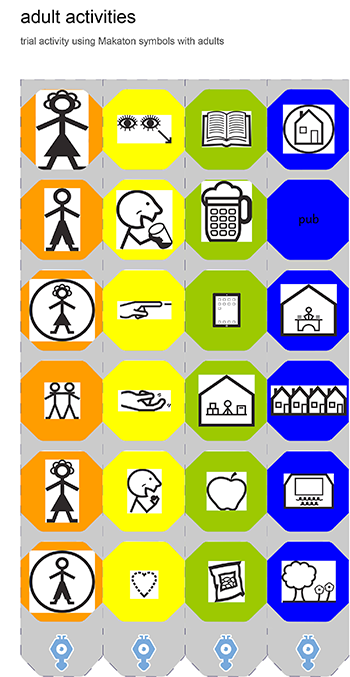About 18 months ago I received delivery of an education tool called Totemigo.
I had been asked to trial it for The Makaton Charity and had no idea
what to expect. As a newly retired learning support teacher in Further
Education and SEN teacher in Special Schools, and as a Makaton Regional
Tutor I was interested to see the latest way of combining communication
learning and Makaton symbols.
I run a community Makaton club
(Makachat) for Makaton users who live semi independently and thought I
would ask them to trial Totemigo. When it arrived, I was surprised to
see that it is an old school object, in several sections which clip
together magnetically with a satisfying clunk. I wanted to handle it
immediately, and so did members of my Makachat group when we met. To use
it requires turning each section so that you see a row of symbols that
make up the syntactically correct sentence, and you can use smaller or
greater numbers of sections as you build competence. My three testers
were able to bring different experience to the challenge.
 You
can use Totemigo with a stimulus picture on the first section, or you
can find your stimulus elsewhere in a real-life situation, video etc. I
populated the Totemigo with topics we suggested by the group, with a
stimulus of a film clip linked to the topics we had been developing in
the group already; signs and symbols to do with socialising in the
community. I populated the Totemigo with concepts we were working on,
and assigned a part of speech to each section, following the Colourful
Semantics themes, i.e.
You
can use Totemigo with a stimulus picture on the first section, or you
can find your stimulus elsewhere in a real-life situation, video etc. I
populated the Totemigo with topics we suggested by the group, with a
stimulus of a film clip linked to the topics we had been developing in
the group already; signs and symbols to do with socialising in the
community. I populated the Totemigo with concepts we were working on,
and assigned a part of speech to each section, following the Colourful
Semantics themes, i.e.
• Who (Subject) – Orange.
• What doing (Verb) – Yellow.
• What (Object) – Green.
• Where – Blue.
Oliver,
William and Christopher are key members of the group. What I loved
about the trial was that each one of them subverted my carefully planned
activity and made it their own. Oliver, looking at the photo I had
screened as a sentence stimulus, wanted to find a concept I hadn’t
managed to include, ‘pub’ (you can now add concepts outside the core
vocabulary). Oliver grasped the potential of the Totemigo immediately.
He silently scanned and turned the Totemigo sections, seemingly
oblivious to prompts. Only once he’d made his decision about his
sentence did he look up and was then happy to speak and sign to explain
it. He remained grumpy that not all the concepts he wanted were there
and was keen for me to give feedback about that.
In
contrast William took the Totemigo, and found it difficult to rotate
the sections, so we took it apart and he looked at the pieces
individually. He discarded one of the sections and worked hard for a
while to put it together. What he came up with was, quite unexpectedly, a
rule for his mum about not using your phone in the cinema! He had
chosen the symbol of ‘woman’ for ‘mum’ and the format allowed us to
compare those two concepts afterwards to remind him of the difference.
Finally,
Christopher had a go. He was less intuitive about the meaning of the
symbols and it was more challenging for him to manipulate the pieces, so
I gave him the sections separately. He had watched the others and
picked up the way in which the other two had clicked the sections
together and was pleased with those satisfying clunks. He could see that
there was meaning in each section and once completed was happy to have a
go at reading it back, with some support. I could see that it held his
attention, allowed him to identify what he knew already and would be a
good way of introducing new concepts to put together.
All
three of the testing group used speech when reading back and signed
when they had their hands free. They all used more concepts in the
sentences they had made, and so were able to communicate in a more
sophisticated way. They all reached for the Totemigo immediately and
were motivated to use it. Finally, it gave them the time to process, to
assimilate the information available and to use it in a way that allowed
them to initiate, in their own time.
Well done everyone!
Totemigo is availble to purchase for £59